Peter Taylor: How has terror changed in 50 years?
- Published
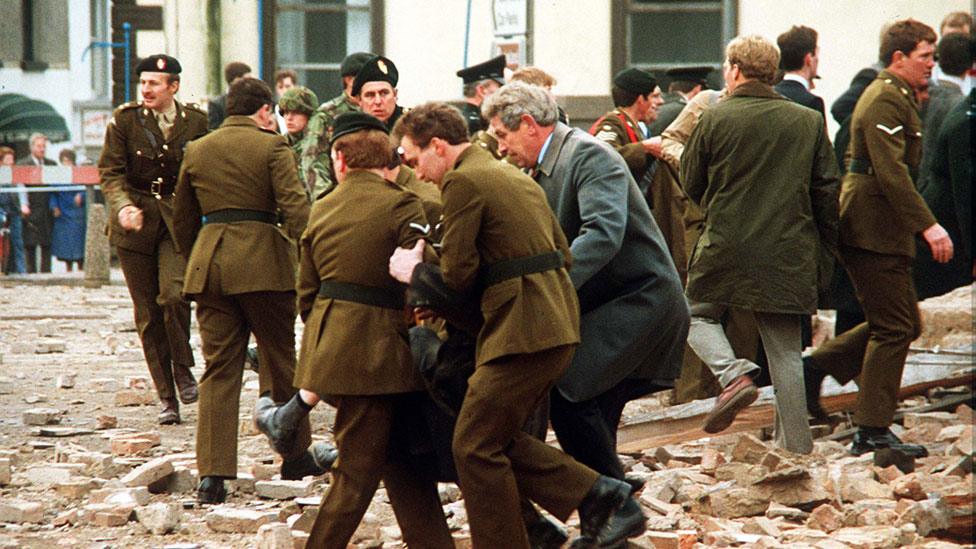
The Enniskillen bombing killed 11 people but became a turning-point
The threat from terrorism is always evolving, but some things remain constant - the emotions of loss and the risks taken by those who want peace, writes Peter Taylor.
When I first started working in television 50 years ago, I never imagined that I would spend much of the next half century reporting the phenomenon of terrorism.
From those early days I have tried to understand the roots of violence and explain not what happens but why it happens.
Gradually I got used to reporting death. But I never became insensitive to it.
During Northern Ireland's Troubles, I got to know a loyalist assassin - Billy Giles - well and grew to like him. I first met him when making a documentary in the Maze Prison in 1989.
I talked to Billy in his cell. He was doing life for the murder of his Catholic workmate. He had lured him into a car and then shot him in the back of the head.
"The only way to stop them was to terrorise them. It was them and us," he said. But the act of pulling the trigger had a profound effect on Billy.
"Before I was a decent young man. It [the conflict] turned me into a killer. It felt like someone had reached down and ripped my insides out. You hear a bang and it's too late. [I] never felt a whole person again."
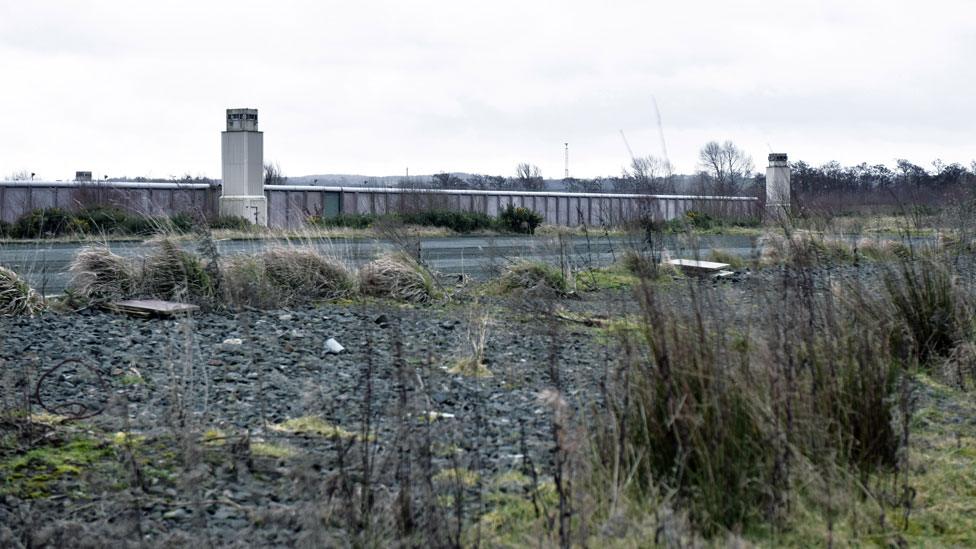
The Maze prison now stands empty
He was released the year before the Good Friday Agreement - which established peace in Northern Ireland - and I met him again. He was a man transformed from the gaunt, haunted figure I'd met in the Maze. He was now wearing a suit, collar and tie and carrying a briefcase.
He looked every inch a businessman and not a loyalist killer. Billy was upbeat and optimistic as he told me about starting a new life. But his ambition proved illusory.
I later heard that he'd hanged himself. I was shattered. I couldn't believe that he'd taken his own life. He left a suicide note. He said he'd ordered a Chinese takeaway, prepared the noose and sat down to write a letter.
"I was a victim too, now hopefully I'll be the last. Please don't let any kid suffer the history I have. Please let our next generation live normal lives. Steer them towards a life that is Troubles free. I've decided to bring this to an end now. I'm tired."
I remember reading Billy's suicide note, hoping that his final wish would come true. At least some of it has.
The emotion that has never left me is the profound sadness I feel for some of those whom I have met, got to know and interviewed. One interview affected me personally above all others.
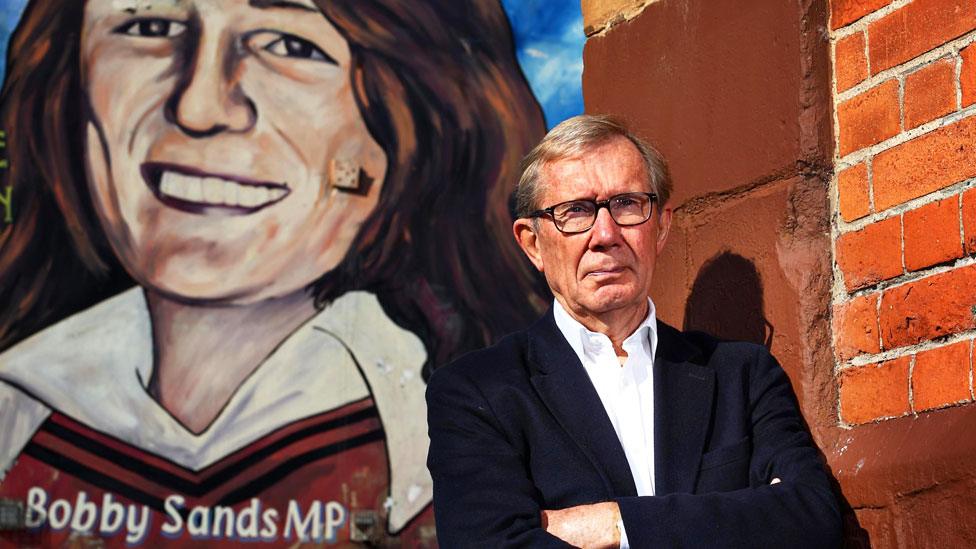
Peter Taylor covered the early years of the Troubles
The blanket protest by the IRA prisoners in the Maze started in 1977. They refused to wear prison uniform, insisting they were political prisoners and not criminals. The protesters resorted to wearing only a blanket to try and force the issue.
To try and understand the situation from the other side of the cell doors, I met Desmond Irvine, the secretary of the Northern Ireland Prison Officers Association.
As a unionist prison officer, what he said came as a surprise. He agreed to do an interview despite the Northern Ireland Office advising him against it. I felt he wanted to get his message across.
I asked if he respected the prisoners for their protest. "I don't think they just do it mainly for publicity but because it's their belief. I suppose one could say a person who believes sincerely in what he is doing, and is prepared to suffer for it, [deserves] a certain measure of respect which you give to him."

Normal life was disrupted for many years in parts of Northern Ireland
After transmission, he wrote me a letter saying how pleased he was with the positive reaction he had had to the interview.
Then a few days later, the IRA shot him dead.
Deeply shocked, I felt sick. At his funeral I cried. And I remember the prison governor telling me not to blame myself, saying he was murdered because he was a prison officer and not because I had interviewed him.
But I'm still haunted by what happened. I was called by a Belfast journalist who asked how it felt to have blood on my hands. Death had come too close to home and I seriously considered stopping reporting Northern Ireland. In the end, I decided to carry on.
The pain I felt was nothing compared with that suffered by loved ones long after victims are forgotten.
Joan Wilson was one of the most unforgettable people I met. She lost her 20-year-old daughter, Marie, a nurse, in the IRA bomb attack on Enniskillen's Remembrance Day parade in November 1987.
Eleven people died, all of them Protestants, and all civilians, apart from one police reservist. Over 60 were injured.
Martin McGuinness: The end of a long journey
How Britain has been kept safe for a decade
Paris attacks: A new type of terrorism?
Joan was at home when the bomb went off. "I thought, well, Gordon [her husband] and Marie are there. I hope nothing terrible has happened."
Both were buried under 6ft of rubble. Gordon managed to reach Marie's hand. "Daddy, I love you very much," were the last words she uttered.
Joan rushed to the hospital knowing little of what had happened. "I was absolutely horrified to see Marie on the bed, wired up. I took her hand, and it was cold. "As we stood there watching her life ebbing away, it ebbed away, and she passed over to our heavenly father in our presence."
The attack did incalculable damage to the IRA and the beginning of the peace process can be traced from that day.
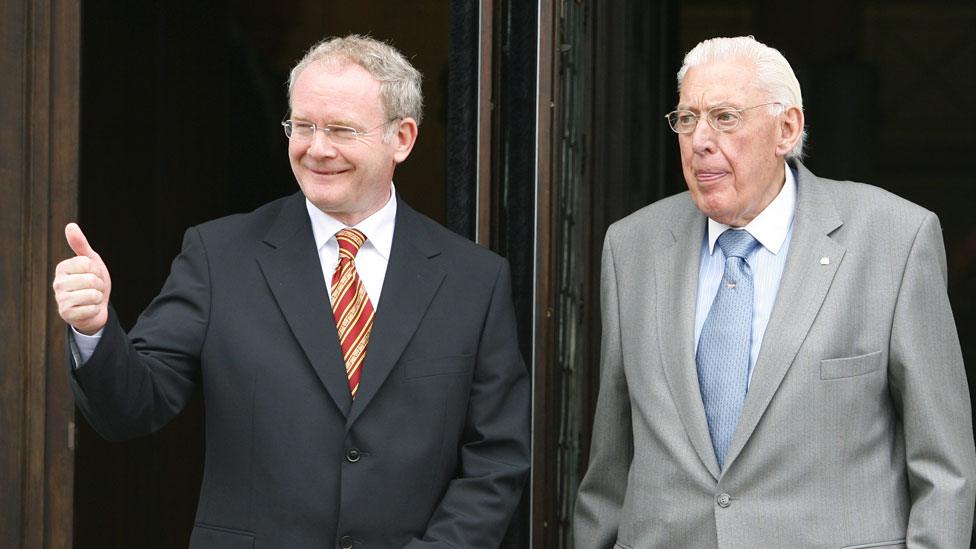
Martin McGuinness and Ian Paisley eventually found compromise
At the time, British and Irish intelligence services believed that Martin McGuinness was the acting head of the IRA's Northern Command - in whose operational area the attack took place - although when I put it to him, he denied it.
I interviewed Joan after McGuinness had become Ian Paisley's partner in the Stormont government's devolved power sharing executive - a sight you might think Joan would find hard to stomach. But that wasn't the case.
"I'm very pleased to see Dr Paisley, whom I regard as a great man of God, sharing with Martin McGuinness, and I think each will be good for the other.
I've spoken to many victims of the IRA's campaign and many, like Lord Tebbit, whose wife Margaret was paralysed in the Brighton bomb, would profoundly disagree.
Tebbit is excoriating in his condemnation of Martin McGuinness and furious at the media hagiography that he believes followed McGuinness's death.
Peace eventually came to Northern Ireland, but other conflicts have proved more intractable.
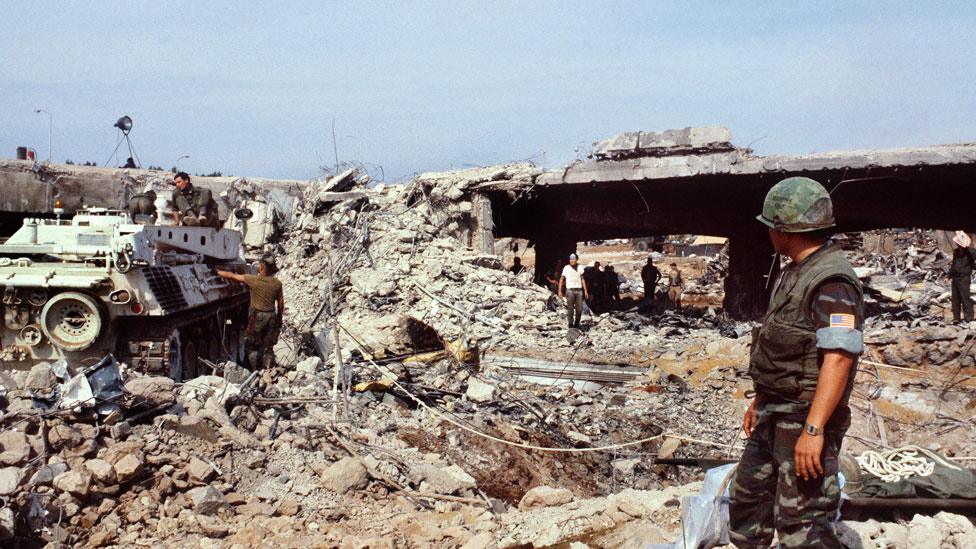
The 1983 Lebanon barracks bombings presaged the widespread modern use of suicide attacks
Going through my archive of over 100 documentaries reminds me of how chillingly prophetic many interviewees have been.
In Lebanon, 25 years ago, I talked to Col Bill Cowan, the US undercover soldier sent to identify the masterminds behind two devastating truck bomb attacks carried out by Islamist suicide bombers in Beirut in 1983.
The first reduced the US Embassy to rubble, killing 63 people including most of the CIA station. Six months later, the second suicide bomber killed 241 US Marines at their base south of Beirut. Many perished in an avalanche of concrete and masonry.
I later interviewed Cowan by one of the few walls left standing - it had been part of a bar and you could still see a Playboy bunny drawn on it. He warned: "Unless we find a way of working with Islamic fundamentalism, we are going to face much, much greater threats over the next decade."
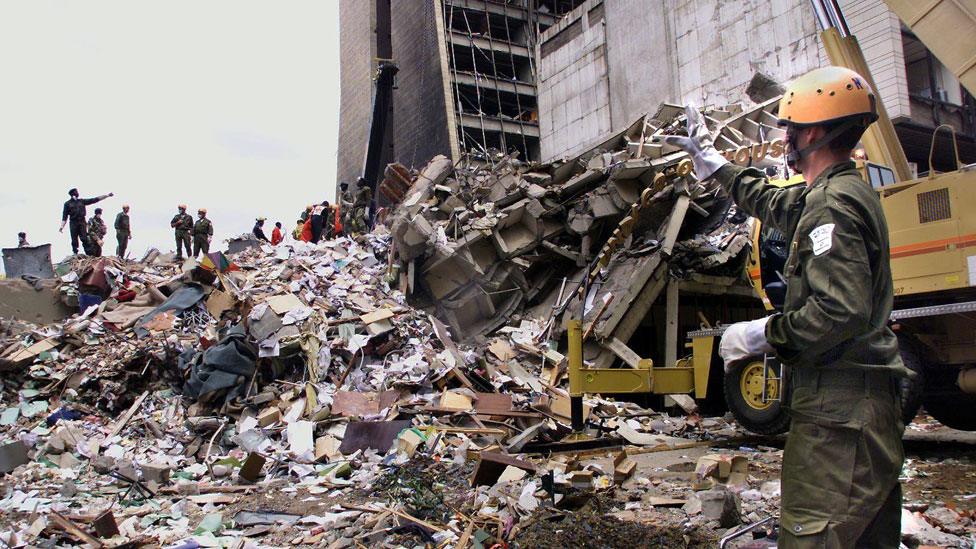
The attack on the embassies in Nairobi and Dar es Salaam brought notoriety to al-Qaeda
The threats went far beyond the next decade. In 1998, al-Qaeda suicide truck bombs shattered two of America's east African embassies, massacring more than 200 people, most of them Muslims.
Then three years later, 9/11 claimed the lives of almost 3,000 - it was a dramatic wake-up call to the world that Cowan's dire warning had come true.
In another interview shortly after 9/11, Dewey Claridge, the spy who helped set up the CIA's Counterterrorism Centre, described what he wanted to see happening to Osama Bin Laden.
"I don't want him brought to trial. I don't want to see a dead body because that just makes him a martyr. I just want him to disappear. Concrete shoes dropped into the Indian Ocean takes care of the dead part of 'dead or alive'."
When British troops went into Northern Ireland
Bin Laden's fate was exactly as Dewey Claridge's crystal ball had predicted.
In Northern Ireland it was a military stalemate that persuaded the British and the IRA to talk.
That stalemate, in which the SAS and its covert intelligence arm, known as the "Det" (for Detachment), left the IRA in no doubt that the "Brits" were not going to allow the IRA to win.
Between 1983 and 1992 the SAS and the Det shot dead 35 IRA suspects.
I remember doing an interview with one "Det" operator, a young woman, who described the celebrations back at base after the killing of IRA volunteer, William Price in 1984. To some of the team, the permanent removal of an IRA man from the battlefield was cause for a party.
"They [the IRA] make no secret of the fact that they celebrate the death of a soldier or policeman," she told me. "We celebrated in the same way. If a terrorist was shot, there was a cake made with their name on it."
Wasn't that macabre? "Possibly," she replied, "but the saying is live by the sword and die by the sword."
I finally found a photo of the cake - in the shape of a cross, with icing round the edges and "RIP" etched above the place where Price was killed.
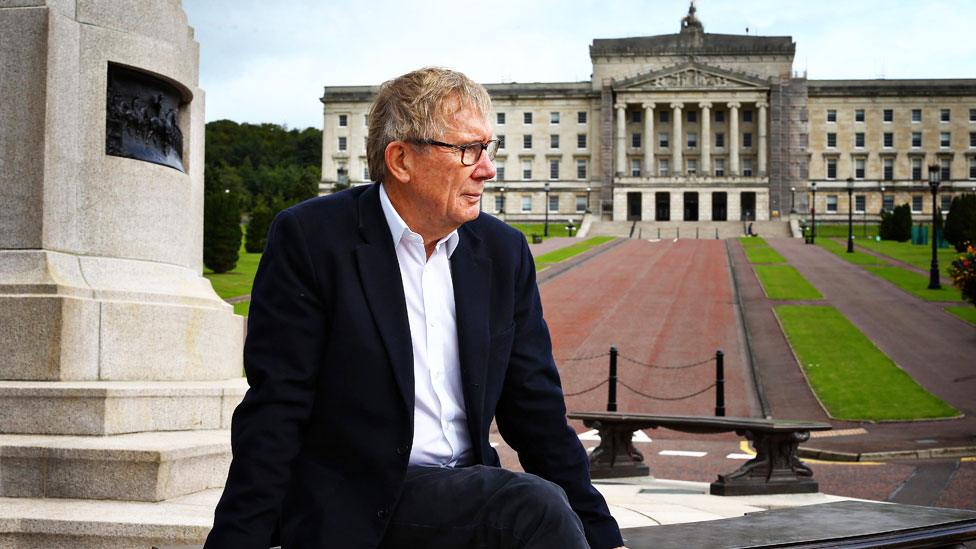
Perhaps the most uplifting stories in the midst of seemingly endless atrocities are about those who have the courage to take great personal risks to work towards peace.
I found that the Derry businessman, Brendan Duddy, displayed extraordinary generosity of spirit. For over 20 years, he was the vital secret back channel intermediary between the MI6 officer Michael Oatley (and later his MI5 successor) and the IRA's ruling Army Council, via Martin McGuinness.
This top secret channel of communication cultivated for so long in the shadows ultimately led to the IRA ceasefire and the Good Friday Agreement.
It took me many months to discover the identity of the mysterious intermediary and when I finally did, to my astonishment, his first words were: "I've been waiting to hear from you."
A long night followed at Duddy's home, in the tiny parlour where many of the secret meetings were held. He told me his remarkable story.
Extraordinarily, IRA leaders were being smuggled over the border and brought in from Belfast for negotiations with the British government via MI6 and MI5.
It was 10 years after our first contact before Brendan finally agreed to an interview.
The emotional stress he had suffered in his efforts to bring peace were apparent in his voice.
He described being present at the seminal first meeting in his parlour between the MI6 officer, Michael Oatley, and Martin McGuinness in 1991.
I asked why he had taken the risks he had. "When you ask questions like that I choke. I get emotional. I find it hard to answer. I had no choice."
But can the principle of engaging with the enemy be applied to other conflicts?
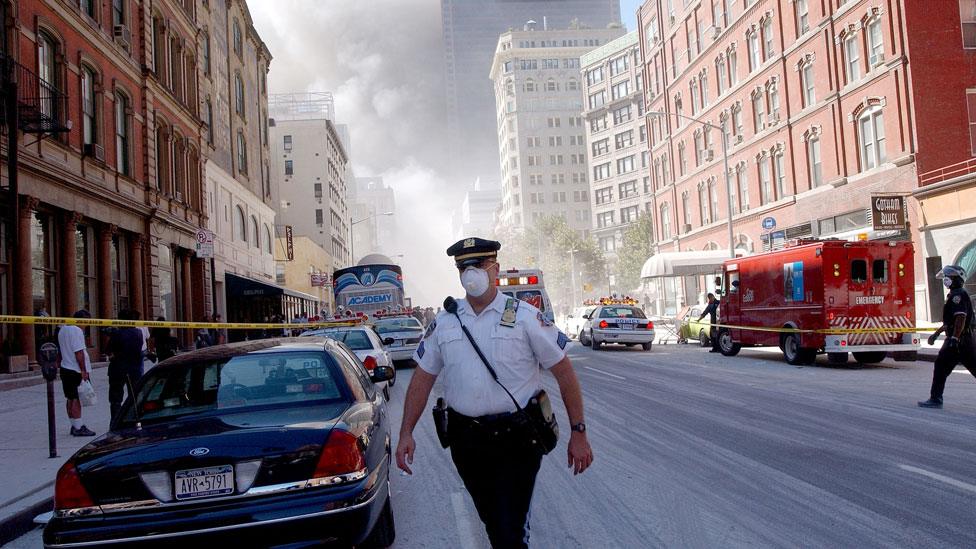
After 9/11 a long and exhaustive hunt for Osama Bin Laden was launched
The former director of MI5, Eliza Manningham Buller, believes that it can. I interviewed her when the main threat came from al-Qaeda, in the wake of the 7/7 London bombings.
The so-called Islamic State was yet to emerge. I asked if the "war on terror" was winnable. "Not in the military sense," she said.
"There won't be a Waterloo or an El Alamein. The terminology about winning the 'war on terror' was not something that I ever subscribed to. It's always better to talk to the people who are attacking you than attacking them. I would hope that people are trying to reach out to the Taliban, to people on the edges of al-Qaeda to talk to them."
So after 50 years what are the lessons to be learned about defeating terrorism?
It has to be tackled on both the military and political front, with both security forces and their political masters being sensitive to the delicate balance between alienating communities and gaining their support.
In the absence of the elusive military victory, governments also need to be ready to engage with the enemy as the British did with the IRA, the Spanish have tried with Eta and most recently the Colombians have achieved with the Farc.
All these were possible because the enemy had a political agenda around which there could be dialogue.
The problem with al-Qaeda and the so-called Islamic State is that their agenda embraces a thousand years not 50. And al-Qaeda and IS are infinitely more ruthless and indiscriminate than the IRA ever was.
It is even difficult, as last week's attack in Westminster shows, to establish whether or not an attacker is genuinely one of their adherents or supporters.
Although victory over IS may be declared in Mosul and Raqqa, the final victory lies not in crushing its armies on the battlefield but in defeating its ideology.
Correction 3 April 2017: This report has been amended to clarify that Billy Giles was released in 1997, not under the Good Friday Agreement a year later.
Peter Taylor's documentary, Fifty Years Behind the Headlines - Reflections on Terror, is on Saturday 1 April at 20:00 BST on BBC Radio Four. Catch up later on iPlayer.